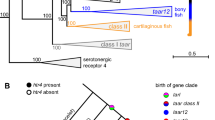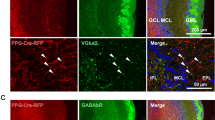Abstract
WE have found the candidate neurotransmitter γ-aminobutyric acid (GABA) and its biosynthetic enzyme in the olfactory nerve of two fish. In the light of these findings current concepts of GABA as an exclusively inhibitory transmitter may have to be reconsidered. The olfactory nerve is a component of the rhinencephalon, a phylogenetically primitive part of the central nervous system (CNS). In addition to its receptive sensory function, the olfactory nerve conducts impulses. Fish have either short olfactory nerves and long olfactory tracts, as do most vertebrates, or long nerves and short tracts, as found in the gar fish (Lepisosteus osseus) and the pike (Esox estor)1. The olfactory cilia and nerve cell body are in the olfactory mucosa, from where the nerve action potentials are propagated to the olfactory bulb, 3 cm (pike) to 15 cm (gar) away, depending on the size of the animal. The primary synapse occurs within the olfactory bulb with the mitral cells. The olfactory nerve in the gar and the pike contains no motor nor other known sensory fibres2,3. Furthermore, it is neurally homogeneous, sensory, unmyelinated and is of a reasonable size for biochemical study (50–150 mg per nerve per fish).
This is a preview of subscription content, access via your institution
Access options
Subscribe to this journal
Receive 51 print issues and online access
$199.00 per year
only $3.90 per issue
Buy this article
- Purchase on Springer Link
- Instant access to full article PDF
Prices may be subject to local taxes which are calculated during checkout
Similar content being viewed by others

References
Gasser, H. S., J. gen. Physiol., 39, 473 (1956).
Easton, D. M., Science, 172, 952 (1971).
Graziadei, P. P. C., in Handbook of sensory physiology, IV (edit. by Beidler, L.), 27–58 (Springer, Berlin, 1971).
Hildebrand, J. G., Barker, D. L., Herbert, E., and Kravitz, E. A., J. Neurobiol., 2, 231 (1971).
Kravitz, E. A., in the Neurosciences, first ed. (edit. by Schmitt, F. O.), 433–444 (Rockefeller University Press, New York, 1967).
Iverson, L. L., in The neurosciences, second ed. (edit. by Schmitt, F. O.), 768–781 (Rockefeller University Press, New York, 1970).
Roskoski, R., jun., Biochemistry, 12, 3709 (1973).
Haber, B., Kuriyama, K., and Roberts, E., Science, 168, 598 (1970).
Haber, B., Kuriyama, K., and Roberts, E., Biochem. Pharm., 19, 1119 (1970).
Jakoby, W. B., and Scott, E. M., J. biol. Chem., 234, 937 (1959).
Ross, S. B., and Renyi, A. L., Eur. J. Pharm., 7, 270 (1969).
Berl, S., and Waelsch, H., J. Neurochem., 3, 161 (1958).
Kravitz, E. A., and Potter, D. D., J. Neurochem., 12, 323 (1965).
Sheridan, J. J., Sims, K. L., and Pitts, F. N., jun., J. Neurochem., 14, 571 (1967).
Baxter, C. F., in Handbook of neurochemistry, III (edit by Lajtha, A), 289–353 (Plenum, New York, 1970).
Susz, J. P., Haber, B., and Roberts, E., Biochemistry, 5, 2870 (1966).
Molinoff, P. B., and Kravitz, E. A., J. Neurochem., 15, 391 (1968).
Fonnum, F., Biochem. J., 103, 262 (1967).
Gray, E. G., and Whittaker, V. P., J. Anat., 96, 79 (1962).
DeRobertis, R., Pellegrino De Iraldi, A., Rodriguez de Lores Arnaiz, G., and Salganicoff, L., J. Neurochem., 9, 23 (1962).
Weinstein, H., Roberts, E., and Kakefuda, T., Biochem. Pharm., 12, 503 (1963).
McGeer, E. G., Gibson, S., Wada, J. A., and McGeer, P. L., Can. J. Biochem., 45, 1943 (1967).
Snyder, S. H., Glowinski, J., and Axelrod, J., Life Sci., 4, 797 (1965).
Schrier, B. K., and Thompson, E. J., J. biol. Chem., 249, 1769 (1974).
Orkand, P., and Kravitz, E. A., J. Cell Biol., 49, 75 (1971).
Krnjevic, K., and Phillis, J. W., J. Physiol., 165, 274 (1963).
Obata, K., Ito, M., Ochi, R., and Sato, N., Expl Brain Res., 4, 43 (1967).
Kravitz, E. A., Kuffler, S. W., and Potter, D. D., J. Neurophysiol., 26, 739 (1963).
Nicoll, R. A., Brain Res., 35, 137 (1971).
McLennan, H., Brain Res., 29, 177 (1971).
Flock, A., and Lam, D. M. K., Nature, 249, 142 (1974).
Margolis, F. L., Science, 184, 909 (1974).
Author information
Authors and Affiliations
Rights and permissions
About this article
Cite this article
ROSKOSKI, R., RYAN, L. & DIECKE, F. γ-Aminobutyric acid synthesised in the olfactory nerve. Nature 251, 526–529 (1974). https://doi.org/10.1038/251526a0
Received:
Revised:
Issue Date:
DOI: https://doi.org/10.1038/251526a0
This article is cited by
-
Resolution and reconstitution of glutamate decarboxylase from cerebellum
Neurochemical Research (1976)
-
Selective release of newly synthesised and newly captured GABA from synaptosomes by potassium depolarisation
Nature (1975)
Comments
By submitting a comment you agree to abide by our Terms and Community Guidelines. If you find something abusive or that does not comply with our terms or guidelines please flag it as inappropriate.


